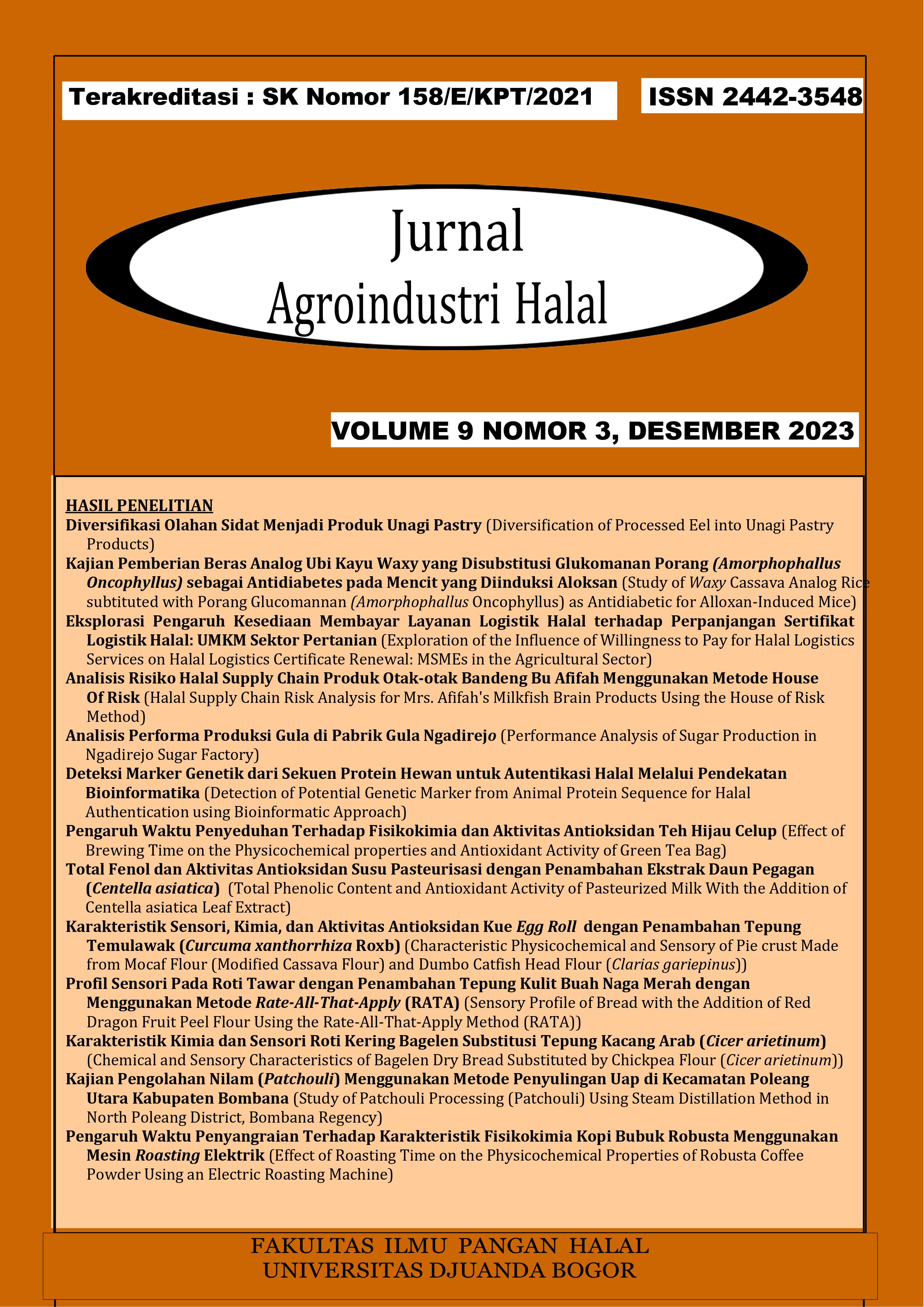Deteksi Marker Genetik dari Sekuen Protein Hewan untuk Autentikasi Halal Melalui Pendekatan Bioinformatika
DOI:
https://doi.org/10.30997/jah.v9i3.6765Keywords:
bioinformatika, IGF2, marker halal, hewan ternakAbstract
Keamanan pangan berupa aspek halal menjadi kebutuhan primer bagi masyarakat Indonesia. Studi bioinformatika menawarkan pendekatan untuk analisis materi genetik organisme dari database yang telah tersedia secara luas. Penelitian ini bertujuan untuk menemukan marker dari sekuens protein beberapa sampel kelompok mamamlia secara in silico dengan pendekatan bioinformatika. Pemilihan sampel urutan protein didasarkan pada protein yang telah banyak dilaporkan secara luas yaitu protein IGF2 (insulin like growth factor 2) dan CytB (cytochrome B). Analisis kekerabatan antar sampel menggunakan konstruksi pohon filogenetik berdasarkan sekuens protein sampel spesies mamalia halal yang dibandingkan dengan sampel mamalia non-halal seperti babi dan anjing. Tahap terakhir adalah analisis struktur dan sifat fisikokimia protein target untuk menentukan marker 'halal'. Analisis pohon filogenetik menunjukkan bahwa spesies babi menempati kelompok yang berbeda dengan mamalia yang umum dikonsumsi di Indonesia dan paling dekat hubungannya dengan spesies anjing. Prediksi sifat protein sampel memberikan informasi kesamaan titik isoelektrik dan karakteristik kelarutan antara sekuens protein spesies babi dan anjing. Dua blok penanda pada sekuen babi dan anjing dari protein IGF2 didapatkan dengan metode multiple sequence alignment berupa urutan YDTWKQSAQRLRRGLPALLRARRGR dan HGGASPEASG. Temuan tersebut dapat menjadi penanda baik secara struktur (urutan) maupun posisinya sebagai acuan dalam pengujian produk halal berbasis DNA, khususnya dengan metode PCR.
References
Aina, G. Q., Rohman, A. & Erwanto, Y. (2020). Wild boar-specific PCR assay and sequence analysis based on mitochondrial cytochrome-b gene for halal authentication studies. Indonesian Journal of Chemistry, 20(2), 483-492. https://doi.org/10.22146/ijc.42552
Ballin, N. Z. (2010). Authentication of meat and meat products. Meat Science, 86(3): 577-587. https://doi.org/10.1016/j.meatsci.2010.06.001
Davoli, R. & Braglia, S. (2008). Molecular approaches in pig breeding to improve meat quality. Briefing in Functional Genomics and Proteomics, 6(4): 313-321. https://doi.org/10.1093/bfgp/elm036
Erwanto, Y., Abidin, M. Z., Sugiyono, E. Y. P. M., & Rohman, A. (2014). Identification of pork contamination in meatballs of Indonesia local market using polymerase chain reaction-restriction fragment length polymorphism (PCR-RFLP) analysis. Asian-Australasian journal of animal sciences, 27(10), 1487-1492. https://doi.org/10.5713/ajas.2014.14014
Fajardo, V., González, I., Rojas, M., García, T., & Martín, R. (2010). A review of current PCR-based methodologies for the authentication of meats from game animal species. Trends in Food Science & Technology, 21(8), 408-421. https://doi.org/10.1016/j.tifs.2010.06.002
Febrita, R. E. & Amaniyah, M. (2021). Deteksi gen potensial hewan ternak untuk autentikasi produk halal menggunakan analisis n-gram. In Seminar Nasional Terapan Riset Inovatif (SENTRINOV) Ke-6. Jurnal Seminar Nasional Terapan Riset Inovatif (SENTRINOV), 7(1): 260–267.
Guntarti, A., Rohman, A., Martono, S., & Yuswanto, A. (2017). Authentication of wild boar meat in meatball formulation using differential scanning calorimetry and chemometrics. Journal of Food and Pharmaceutical Sciences, 5(1), 8-12. https://doi.org/10.14499/jfps
Gutteridge, A. & Thornton, J. M. (2005). Understanding nature's catalytic toolkit. Trends in biochemical sciences, 30(11): 622-629. https://doi.org/10.1016/j.tibs.2005.09.006
Hall, B. G. (2013). Building phylogenetic trees from molecular data with MEGA. Molecular biology and evolution, 30(5), 1229-1235. https://doi.org/10.1093/molbev/mst012
He, Z., & Yang, H. (2018). Colourimetric detection of swine-specific DNA for halal authentication using gold nanoparticles. Food Control, 88, 9-14. https://doi.org/10.1016/j.foodcont.2018.01.001
Hermanto, S., Rudiana, T., Zein, M. I. H. L., & Wisudawati, A. W. (2022). Methods validation of pork authentication in processed meat products (sausages) through densitometry analysis. Indonesian Journal of Halal Research (IJHAR), 4(1): 35-44. https://doi.org/10.15575/ijhar.v4i1.11892
Hsieh, M. K., Shih, P. Y., Wei, C. F., Vickroy, T. W., & Chou, C. C. (2016). Detection of undeclared animal by‐products in commercial canine canned foods: Comparative analyses by ELISA and PCR‐RFLP coupled with slab gel electrophoresis or capillary gel electrophoresis. Journal of the Science of Food and Agriculture, 96(5), 1659-1665. https://doi.org/10.1002/jsfa.7268
Huang, Y.Z., Wang, J., Zhan, Z.Y., Cao, X.K., Sun, Y.J., Lan, X.Y., Lei, C.Z., Zhang, C.L. & Chen, H. (2013). Assessment of association between variants and haplotypes of the IGF2 gene in beef cattle. Gene, 528(2): 139-145. https://doi.org/10.1016/j.gene.2013.07.035
Kumar, S., Stecher, G., Li, M., Knyaz, C., & Tamura, K. (2018). MEGA X: Molecular evolutionary genetics analysis across computing platforms. Molecular Biology and Evolution, 35(6): 1547–1549. https://doi.org10.1093/molbev/msy096
Lestari, T. R. P. (2020). Keamanan pangan sebagai salah satu upaya perlindungan hak masyarakat sebagai konsumen. Aspirasi: Jurnal Masalah-Masalah Sosial, 11(1), 57–72. https://doi.org/10.46807/aspirasi.v11i1.1523
Lopez-Oceja, A., Nuñez, C., Baeta, M., Gamarra, D. & De Pancorbo, M. M. (2017). Species identification in meat products: a new screening method based on high resolution melting analysis of cyt b gene. Food chemistry, 237: 701-706. https://doi.org/10.1016/j.foodchem.2017.06.004
Nakyinsige, K., Man, Y. B. C. & Sazili, A. Q. (2012). Halal authenticity issues in meat and meat products. Meat science, 91(3): 207-214. https://doi.org/10.1016/j.meatsci.2012.02.015
Premanandh, J. & Bin Salem, S. (2017). Progress and challenges associated with halal authentication of consumer packaged goods. Journal of the Science of Food and Agriculture, 97(14): 4672-4678. https://doi.org/10.1002/jsfa.8481
Sievers F., & Higgins D.G. (2014). Clustal Omega, accurate alignment of very large numbers of sequences. In: Russell D. (eds) Multiple Sequence Alignment Methods. Methods in Molecular Biology (Methods and Protocols), vol 1079. (pp. 105-116). Totowa, NJ: Humana Press.
Tamura, K., Stecher, G., Peterson, D., Filipski, A., & Kumar, S. (2013). MEGA6: molecular evolutionary genetics analysis version 6.0. Molecular biology and evolution, 30(12), 2725-2729. https://
doi.org/10.1093/molbev/mst197
von Bargen, C., Brockmeyer, J., & Humpf, H. U. (2014). Meat authentication: a new HPLC–MS/MS based method for the fast and sensitive detection of horse and pork in highly processed food. Journal of Agricultural and Food Chemistry, 62(39), 9428-9435. https://doi.org/10.1021/jf503468t
Xiong, J. (2006). Essential Bioinformatics. New York: Cambridge University Press.
Zhang, Y. (2008). Progress and challenges in protein structure prediction. Current opinion in structural biology, 18(3): 342-348. https://doi.org/10.1016/j.sbi.2008.02.004
Downloads
Published
How to Cite
Issue
Section
License
Copyright (c) 2023 Maghfirotul Amaniyah, Ruth Ema Febrita, Junaedi Adi Prasetyo

This work is licensed under a Creative Commons Attribution-ShareAlike 4.0 International License.
Authors who publish with Jurnal Agroindustri Halal agree to the following terms:
- Authors retain copyright and grant the journal right of first publication with the work simultaneously licensed under a Creative Commons Attribution 4.0 International License that allows others to share the work with an acknowledgement of the work's authorship and initial publication in Jurnal Agroindustri Halal.
- Authors are able to enter into separate, additional contractual arrangements for the non-exclusive distribution of the journal's published version of the work (e.g., post it to an institutional repository or publish it in a book), with an acknowledgement of its initial publication in Jurnal Agroindustri Halal.
- Authors are permitted and encouraged to post their work online (e.g., in institutional repositories or on their website) prior to and during the submission process, as it can lead to productive exchanges, as well as earlier and greater citation of published work









